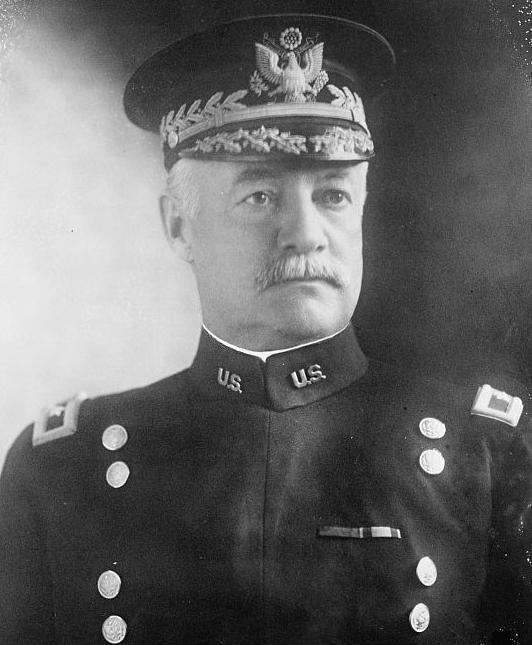Years of service 1879–1921 | Name Hunter Liggett | |
 | ||
Born March 21, 1857Reading, Pennsylvania ( 1857-03-21 ) Allegiance United States of America | ||
C 17 landing fort hunter liggett
Hunter Liggett (March 21, 1857 – December 30, 1935) was a senior United States Army officer. His 42 years of service spanned the period from the Indian campaigns to trench warfare of World War I. Additionally, he identified possible invasion sites in Luzon, particularly Lingayen Gulf, which were used during World War II in 1941 by the Japanese and in 1945 by the Americans.
Contents
- C 17 landing fort hunter liggett
- Fort Hunter Liggett Presents United We Band
- Early life
- First World War
- Retirement and death
- Military honors
- Army Distinguished Service medal citation
- Other honors
- References
Fort Hunter Liggett Presents - United We Band
Early life
Liggett was born March 21, 1857 in Reading, Pennsylvania. After his graduation from West Point as a second lieutenant in 1879, he was assigned to the 5th Infantry, where he served in both the Montana and Dakota territories, as well as Texas and Florida, during which time he reached the rank of Captain.
His field service in the American west, the Spanish–American War, and the Philippine–American War honed his skills as a military leader.
In 1907, he assumed command of a battalion of the 13th Infantry Regiment at Fort Leavenworth, Kansas. From 1909 to 1914, he served as student, faculty member, and president at the Army War College, receiving a promotion to brigadier general in February 1913.
Liggett's services in the Philippines included setting up a staff ride in 1914 to study possible invasion sites on Luzon. He was assisted in this by his aide de camp, Captain George Marshall. The staff ride established that the most likely invasion route would be through the Lingayen Gulf and that this would be all but unstoppable unless the US dramatically increased its Army and Navy forces in the Philippines. In 1941, the Japanese invaded through the Lingayen Gulf, as the US did in turn in 1945.
First World War
Success in brigade commands in Texas and in the Philippines led to his promotion to major general, and selection as commander of the 41st Division in April 1917. The division served in France as part of the American Expeditionary Force. When his division was disestablished, he took command of I Corps.
Under Liggett's leadership, the I Corps participated in the Second Battle of the Marne and in the reduction of the Saint-Mihiel salient. In October 1918, as commander of the US First Army, he directed the final phases of the Meuse-Argonne offensive and the pursuit of German forces until the armistice.
He wrote about his war time experiences in A.E.F.: Ten Years Ago in France (1928).
Retirement and death
After commanding the U.S. Third Army, also known as the Army of Occupation, on the Rhein bridgeheads, Hunter Liggett retired in 1921. Congress promoted him to permanent lieutenant general in 1930. He died December 30, 1935 in San Francisco, California and is interred at the San Francisco National Cemetery, San Francisco, California. His grave can be found in the officers section 3, plot 1.
Military honors
Army Distinguished Service medal citation
The President of the United States of America, authorized by Act of Congress, July 9, 1918, takes pleasure in presenting the Army Distinguished Service Medal to Lieutenant General Hunter Liggett, United States Army, for exceptionally meritorious and distinguished services to the Government of the United States, in a duty of great responsibility during World War I. As Commander of the 1st Army of the American Expeditionary Forces, General Liggett commanded the 1st Army Corps and perfected its organization under difficult conditions of early service in France, engaged in active operations in reduction of the Marne salient and of the St. Mihiel salient, and participated in the actions in the Forest of Argonne; in command of the 1st Army when German resistance was shattered west of the Meuse.
Other honors
In his honor, the United States Army named a base on California's central coast, Fort Hunter Liggett.
Liggett Hall is a regimental-sized barracks building constructed at Fort Jay on Governors Island in New York Harbor. Completed in 1930, it was thought to be the largest building constructed by the U.S. Army and was the largest structure built under the supervision of the U.S. Army Quartermaster Corps. It was superseded by the Pentagon, constructed by the U.S. Army Corps of Engineers in 1943.
The USS Hunter Liggett was a passenger ship that was transferred to the Army and renamed Hunter Liggett in February 1939. The ship transported personnel and supplies until May 27, 1941, when she was turned over to the Navy. Converted to Navy use at Brooklyn Navy Yard, she re-commissioned as AP-27 June 9, 1941, and then again reclassified APA-14 February 1, 1943 for the United States Coast Guard.
